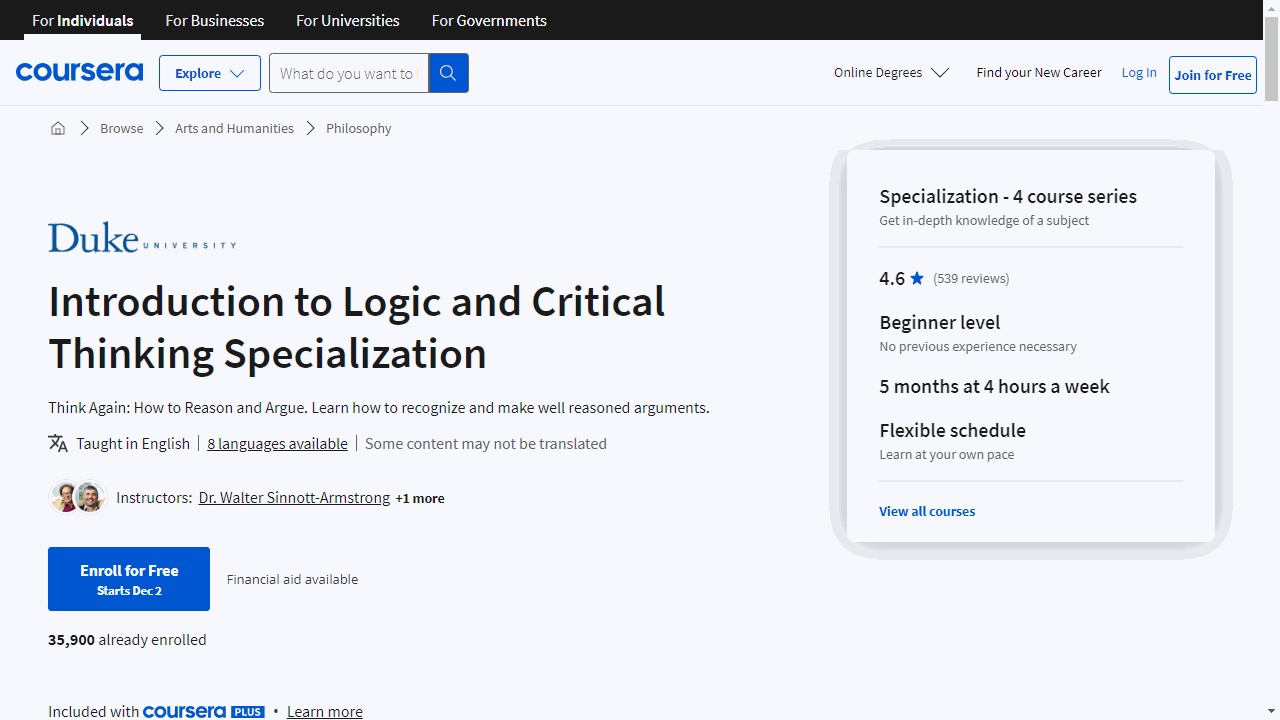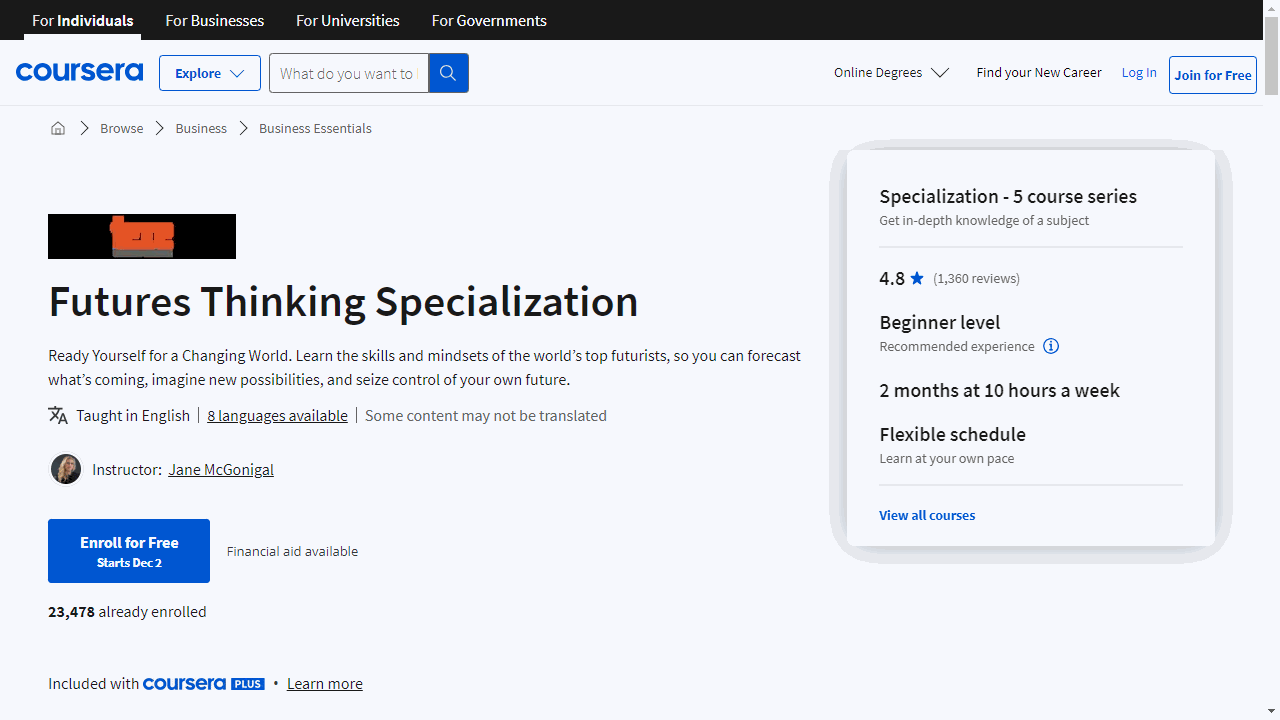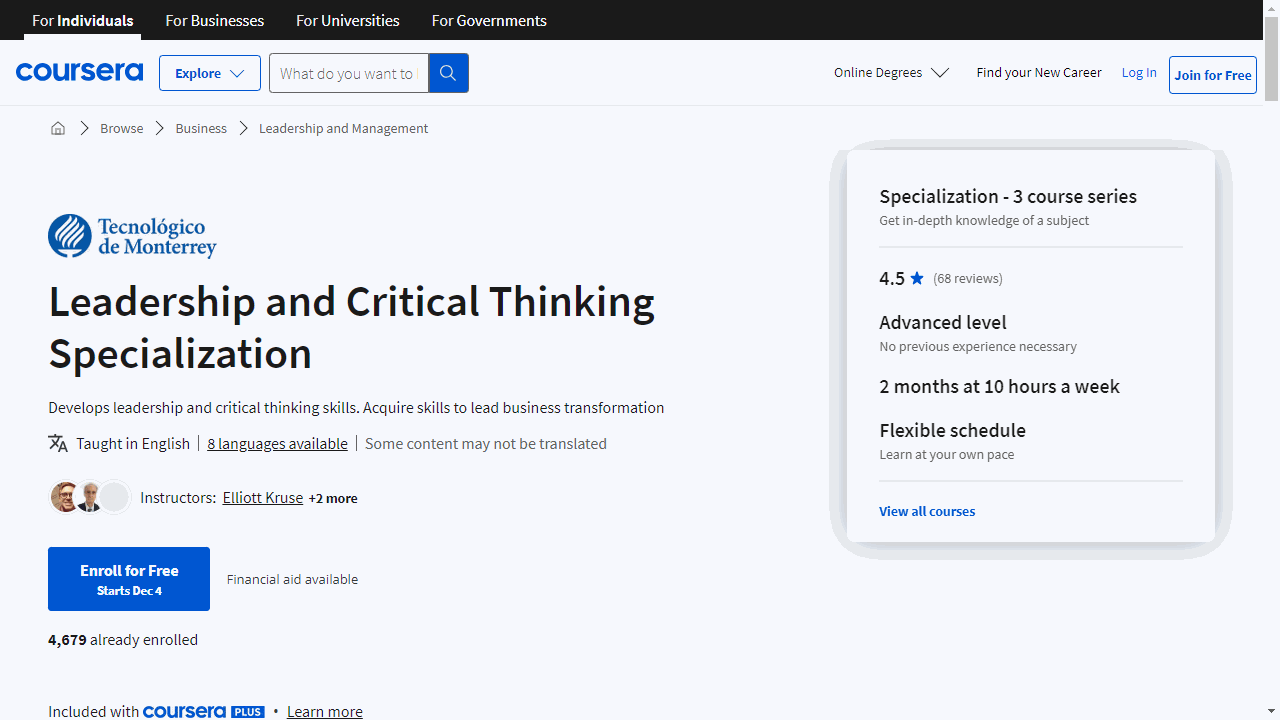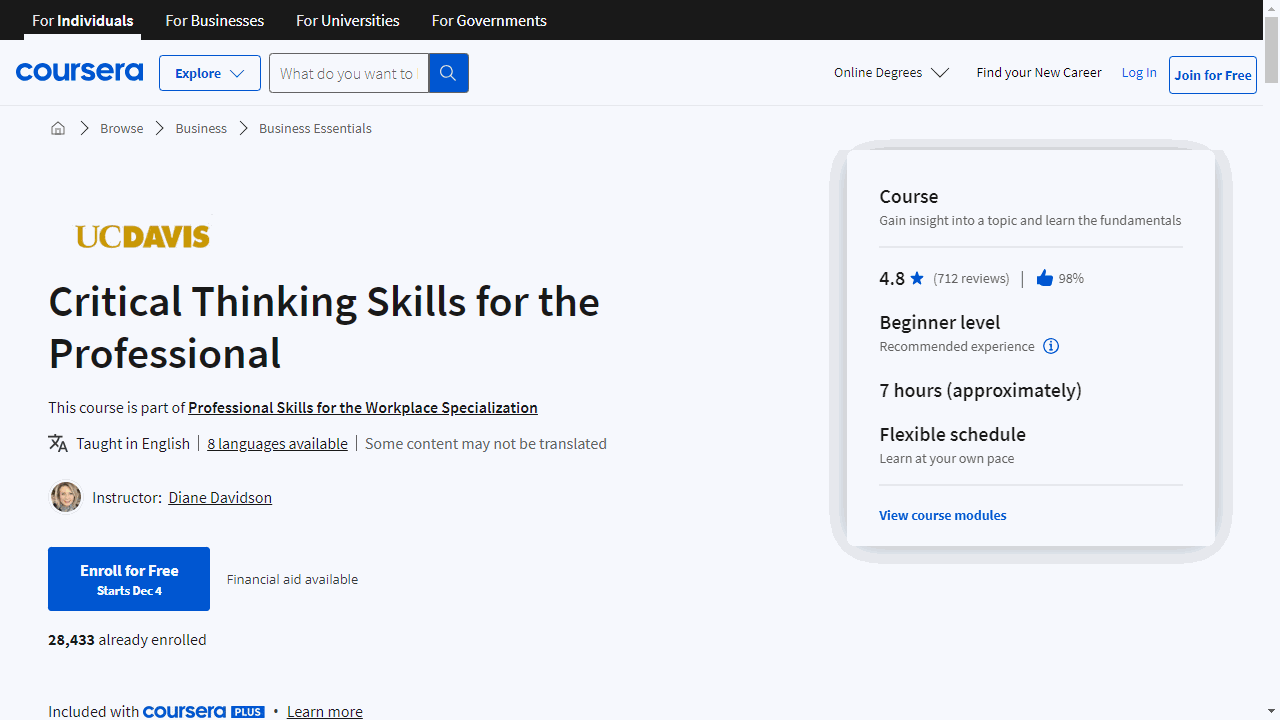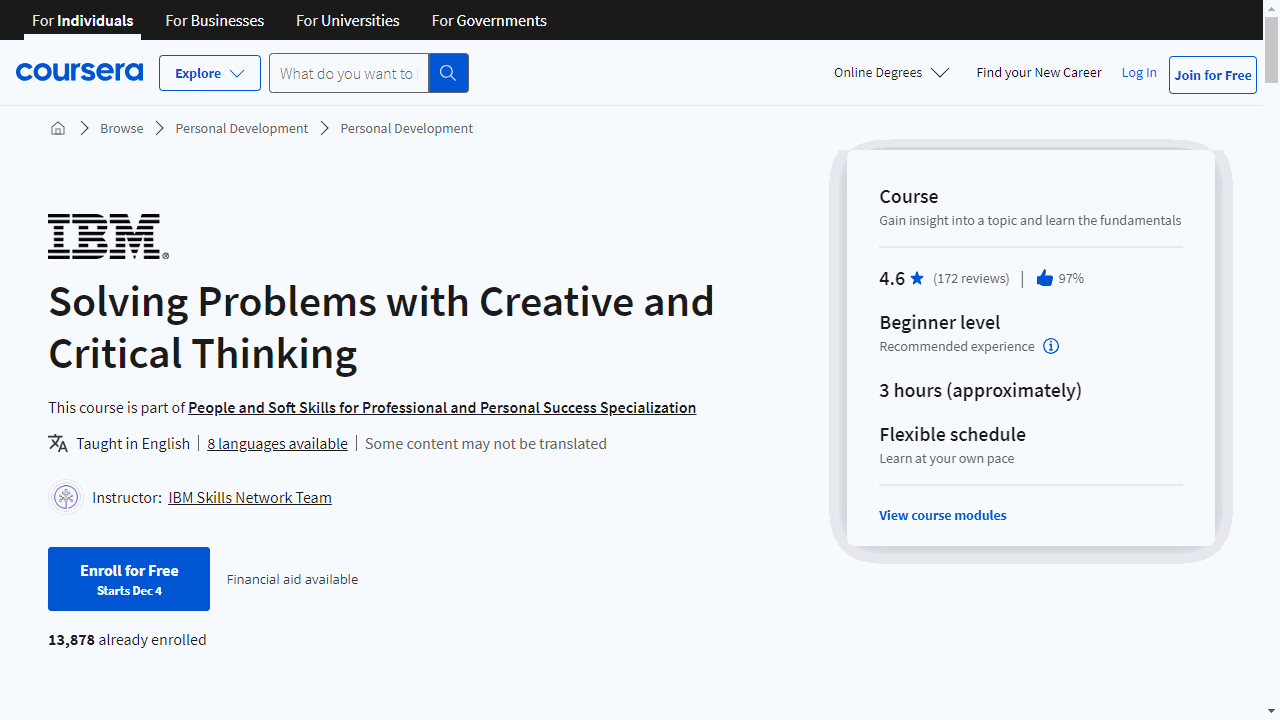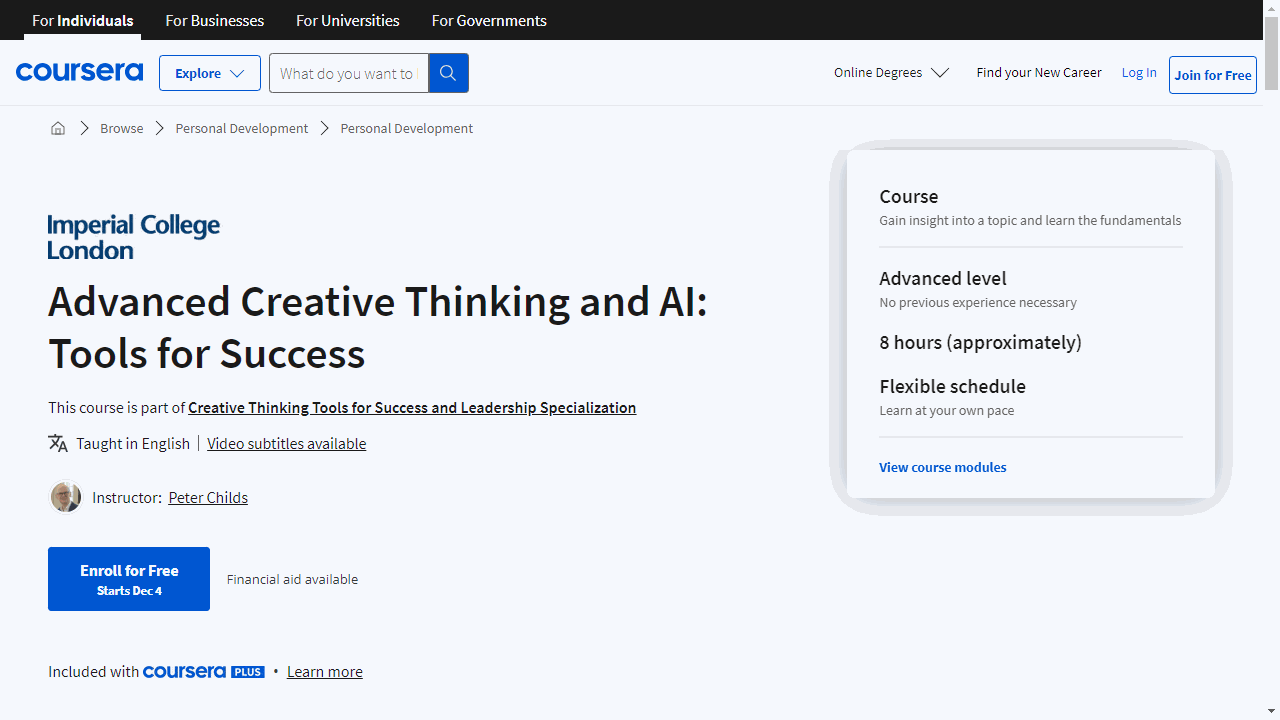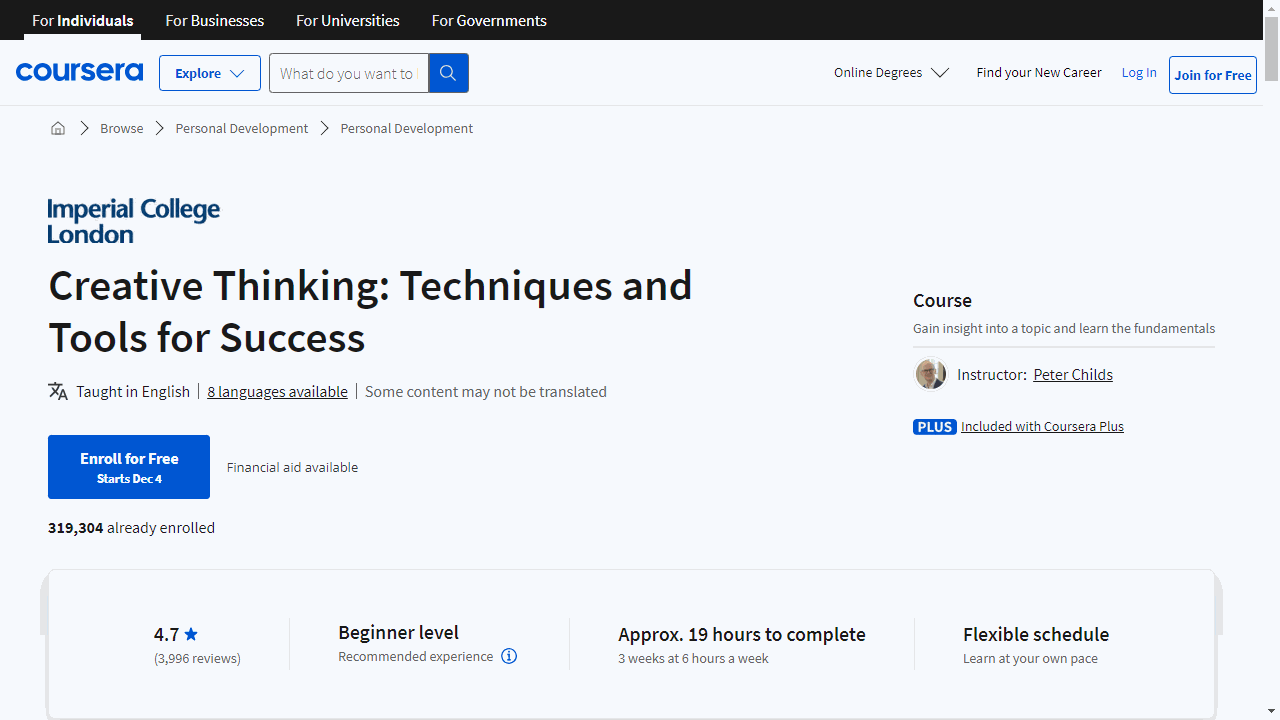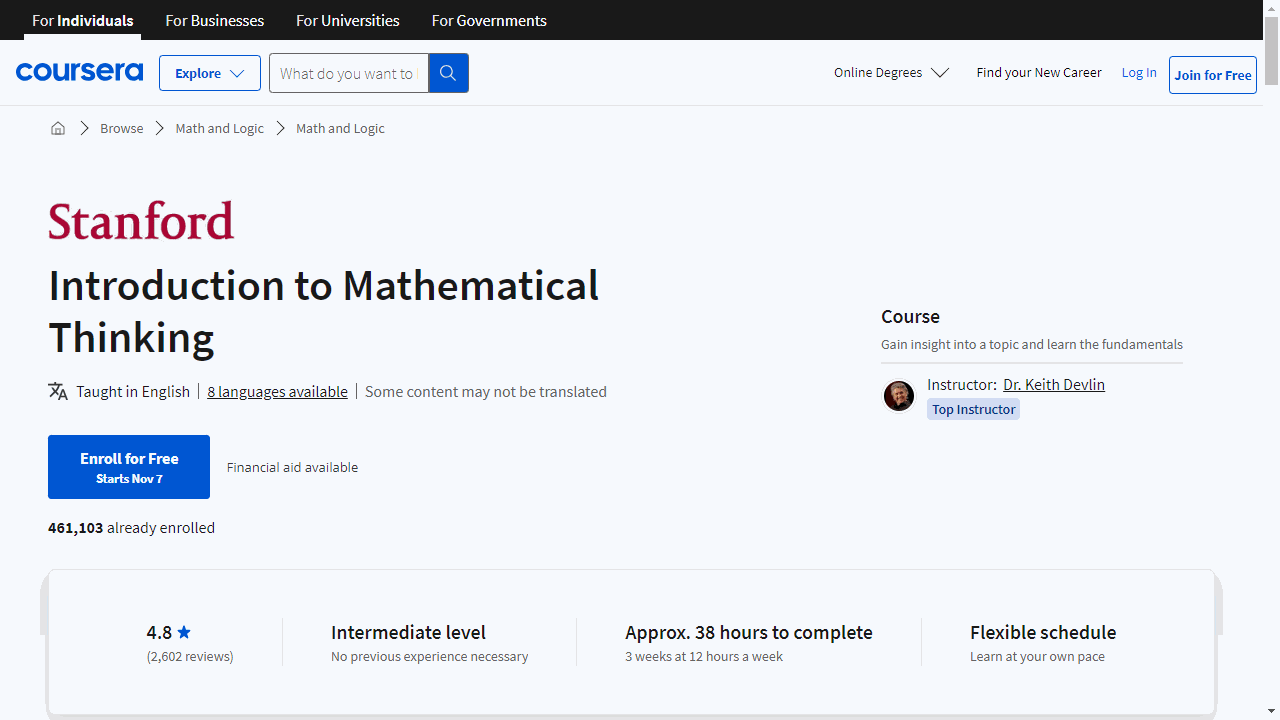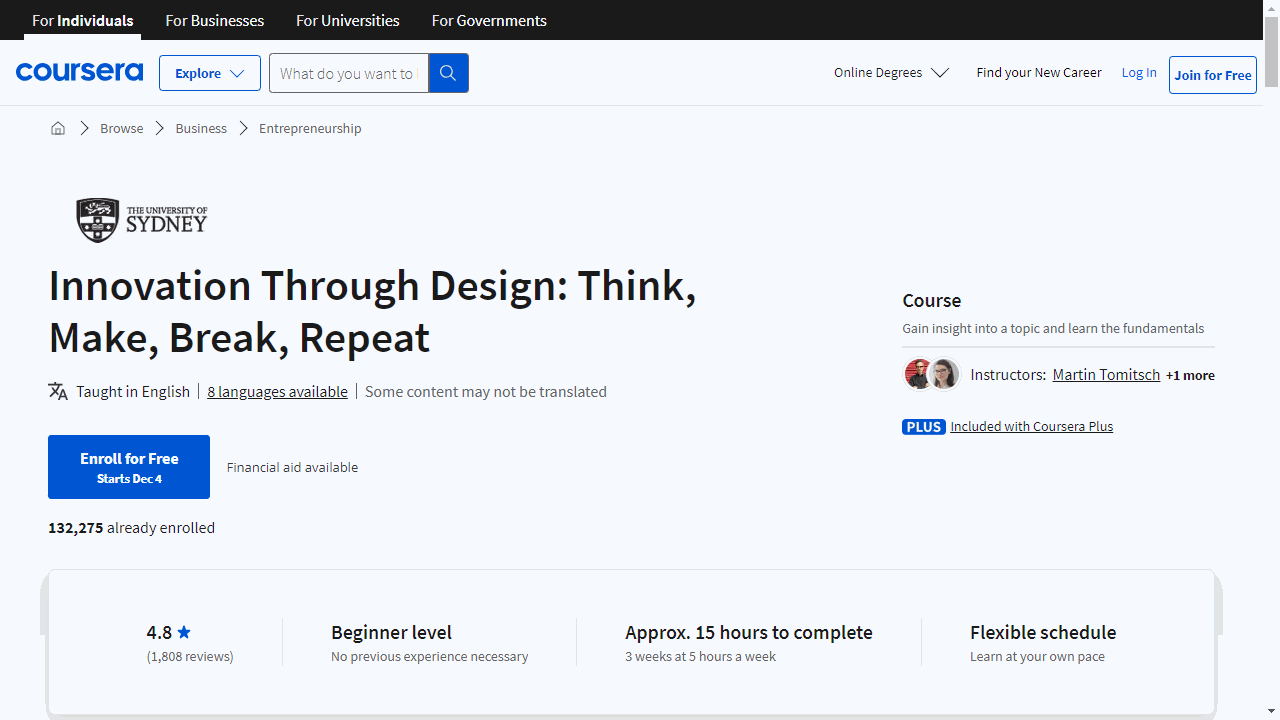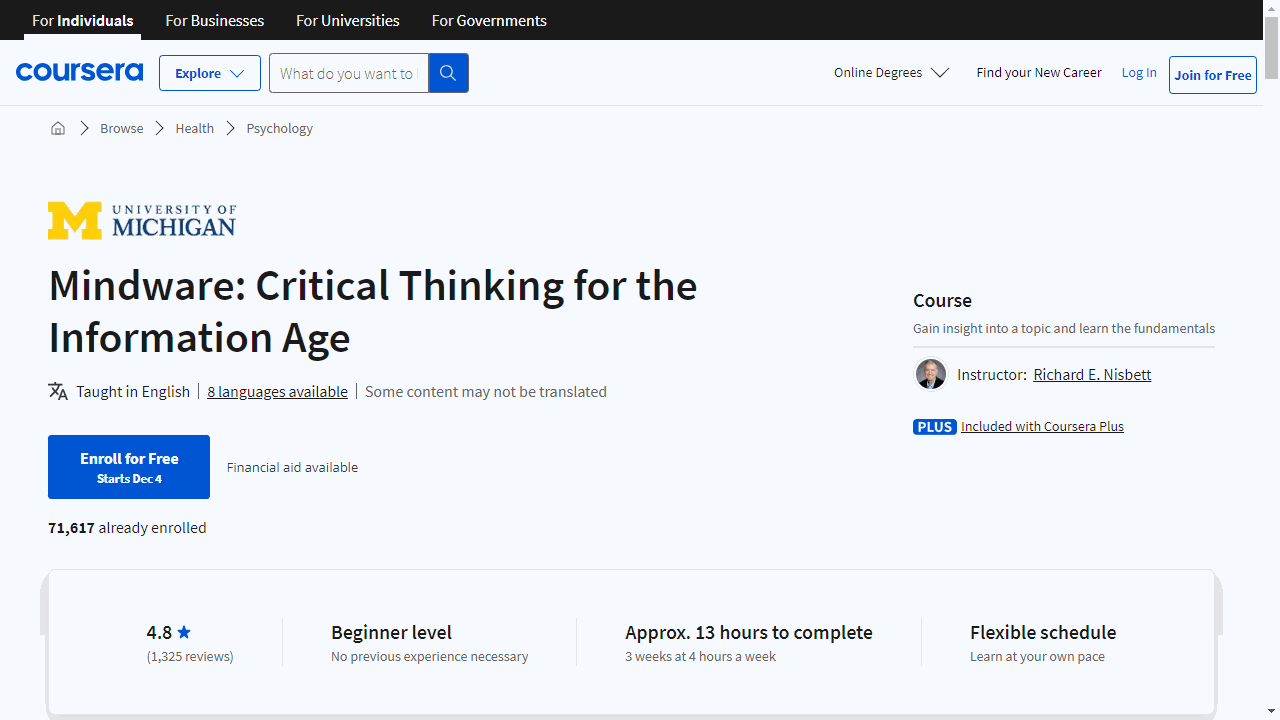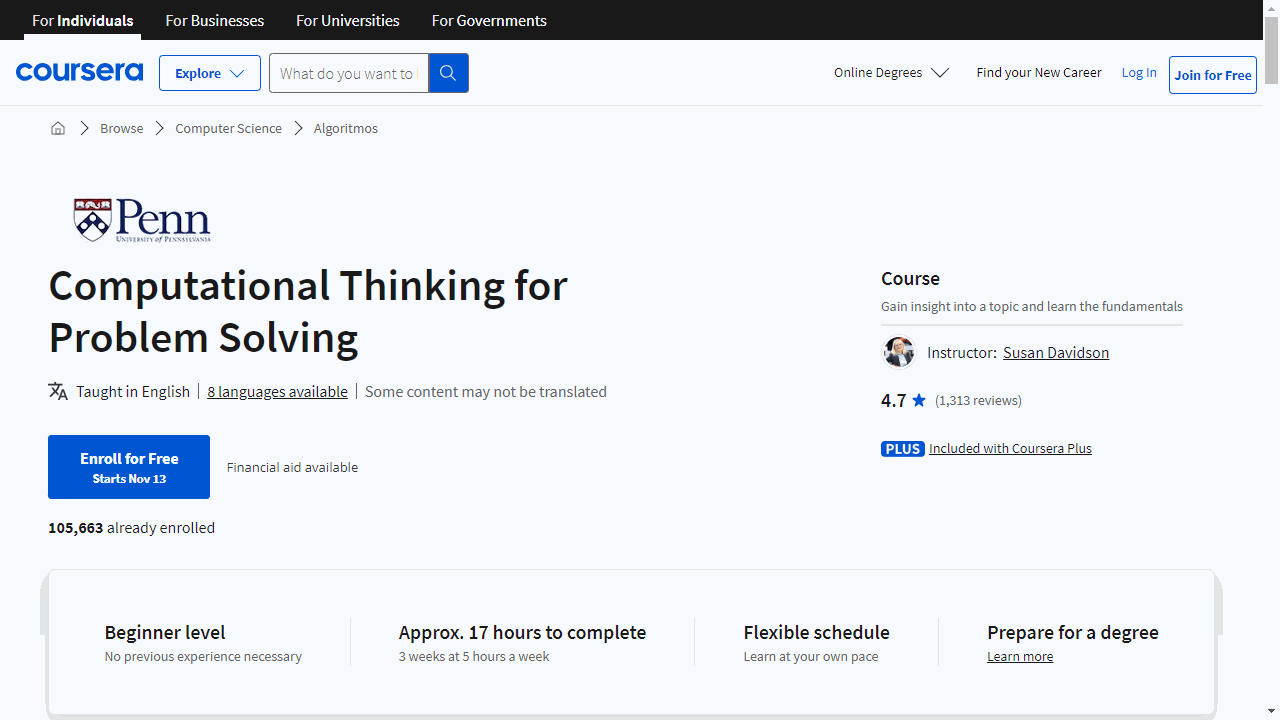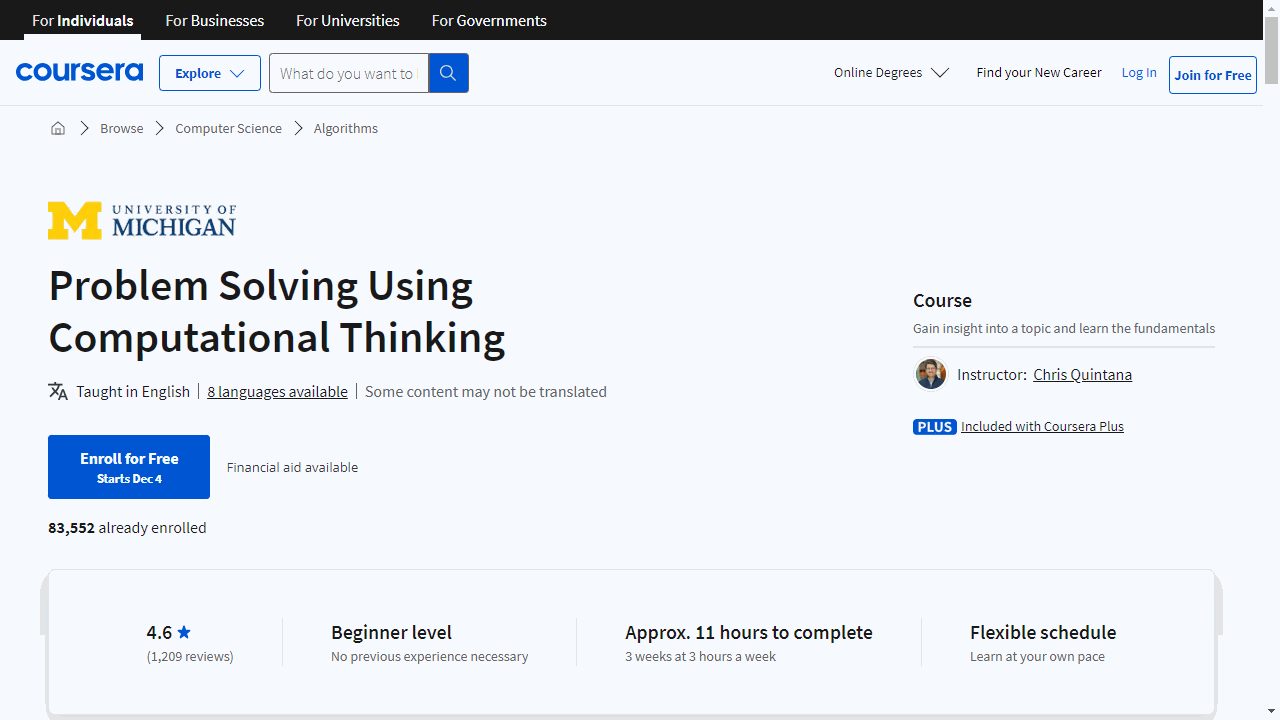Critical thinking is a vital skill in today’s world, allowing you to analyze information, form sound judgments, and make informed decisions.
It’s not just about being good at arguing; it’s about developing a logical and rational approach to understanding complex ideas and tackling challenging problems.
Mastering critical thinking can boost your confidence in decision-making, improve your communication skills, and even help you achieve greater success in your studies and career.
Finding the right critical thinking course on Coursera can be overwhelming, with so many options available.
You’re looking for a program that’s engaging, taught by experts, and tailored to your learning style.
We’ve reviewed countless courses and based on our analysis, the “Introduction to Logic and Critical Thinking Specialization” from Duke University is the best overall course.
This specialization offers a structured and engaging journey through the fundamentals of logic and critical thinking, equipping you with the tools to analyze arguments, identify fallacies, and strengthen your reasoning abilities.
While this specialization is a great starting point, there are other fantastic critical thinking courses available.
Keep reading to discover more options tailored to different learning levels and goals.
Introduction to Logic and Critical Thinking Specialization
This series from Duke University hones critical thinking and argument analysis skills.
You’ll master argument construction and evaluation, boosting your reasoning abilities and decision-making confidence.
Start with “Think Again I: How to Understand Arguments,” where you’ll learn to identify and dissect arguments, enhancing your ability to engage with complex ideas.
The course includes weekly videos and quizzes, with optional deeper reading available in “Understanding Arguments.”
Progress to “Think Again II: How to Reason Deductively,” where you’ll employ truth-tables and Venn diagrams to validate arguments, ensuring your conclusions are sound.
This analytical skill is crucial for clear, logical thinking.
In “Think Again III: How to Reason Inductively,” you’ll tackle real-world problems using inductive reasoning, from solving mysteries to making everyday decisions.
You’ll also explore how probability can inform your decision-making process.
Finally, “Think Again IV: How to Avoid Fallacies” empowers you to recognize and steer clear of common reasoning errors.
Understanding fallacies equips you to critically evaluate arguments and avoid being misled.
Futures Thinking Specialization
This series of courses from the Institute for the Future equips you with the tools to predict, prepare for, and influence what’s to come.
Start with “Ready, Set, Future!
Introduction to Futures Thinking,” where you’ll grasp the basics of futures thinking, learn to spot trends, and avoid being caught off-guard by change.
It’s ideal if you’re looking to drive innovation in your personal and professional life.
In “Forecasting Skills: See the Future Before it Happens,” you’ll dive deeper into turning clues about the future into actionable forecasts.
This course sharpens your ability to envision multiple futures, helping you guide others in preparing for potential scenarios.
“Simulation Skills: This is Your Brain on the Future” tackles the neurological challenges of future planning.
You’ll practice techniques to enhance your strategic thinking, making you more effective in anticipating future events.
“Collaborative Foresight: How to Game the Future” introduces you to multiplayer gaming methods for foresight.
If you’re interested in understanding diverse perspectives and reducing blind spots, this course offers innovative tools for collaborative future planning.
Lastly, “Urgent Optimism: How to Turn Foresight into Action” empowers you to act on your foresight skills.
You’ll learn to craft a vision for the future, overcome obstacles, and mobilize others to join your cause.
Each course is packed with specific, actionable skills that will help you not just predict the future, but shape it.
Leadership and Critical Thinking Specialization
This specialization offered by Tecnológico de Monterrey is a comprehensive learning journey, equipping you with the skills to think deeply, lead with impact, and contribute positively to your surroundings.
Each course is packed with insights and practical skills to enhance your leadership and decision-making abilities.
Dive into “Leadership and Organizational Behavior” to uncover the psychological underpinnings of effective leadership.
You’ll learn to craft a personal leadership style, motivate others, and communicate persuasively.
This course equips you with strategies to understand and guide people towards common goals.
In “Critical Thinking: Reasoned Decision Making,” you’ll tackle the complexities of modern decision-making.
This course sharpens your ability to challenge assumptions and view problems from multiple perspectives.
You’ll master a methodology for critical thinking, analyze its standards, and apply it to group dynamics, enhancing your problem-solving in business and social contexts.
“Leadership Focused on Human Flourishing” rounds out the specialization by connecting leadership with well-being.
It prepares you to be a resilient leader who fosters a positive environment and promotes growth.
You’ll identify personal improvement opportunities and learn the interplay between happiness, leadership, and success.
Critical Thinking Skills for University Success
This course offered by The University of Sydney equips you with essential skills to analyze and construct arguments effectively.
You’ll start with an introduction to academic culture and the foundational elements of critical thinking.
The course emphasizes the importance of academic integrity and prepares you for the challenges of university-level work.
Diving deeper, you’ll develop the right mindset for critical thinking, guided by expert videos.
You’ll learn to navigate different argument contexts and enhance your questioning techniques, a vital component of critical thinking.
The course then introduces you to formal logic, helping you identify common reasoning fallacies and understand various forms of reasoning.
Systems thinking is also covered, enabling you to see connections in complex issues.
You’ll become adept at evaluating claims and evidence, recognizing biases and assumptions, and using criteria to assess arguments.
The course also delves into the different types of arguments, ensuring you can distinguish and construct them with precision.
Later, you’ll explore argument structures and chains, learn models for academic argumentation, and apply critical thinking to critique and reflective writing.
These skills are not only academic but also applicable in everyday problem-solving.
Peer assessments throughout the course provide practical experience and insights into diverse approaches to critical thinking.
By the end, you’ll have a comprehensive understanding of critical thinking, ready to apply in your academic and personal life.
The course concludes with a reflective exercise and a summative assessment to consolidate your learning.
Critical Thinking Skills for the Professional
This course offered by University of California, Davis equips you with the tools to tackle problems effectively in a professional context.
You’ll start by understanding the root of problems and the concept of kinetic memorization, which helps you retain information through action.
Identifying problems accurately is a key focus, ensuring you’re solving the right issues.
Reframing problems is next, teaching you to view challenges from various perspectives to unlock new solutions.
You’ll set specific learning goals, streamlining your progress through the course.
Effective brainstorming is crucial, and you’ll learn to generate ideas both individually and in groups.
You’ll use Jamboard for collaborative sessions, enhancing your ability to work with remote teams.
After brainstorming, you’ll select three solutions, analyzing their strengths and weaknesses to make informed decisions.
The course also guides you through presenting recommendations convincingly, highlighting dos and don’ts, and the importance of constructive feedback.
In the final stages, you’ll reflect on personal triggers, gaining insights into emotional responses that can impact decision-making.
With recommended readings supplementing each module, the course offers a comprehensive approach to developing your critical thinking skills.
You’ll not only understand the theories but also know how to apply them practically, making you a more effective problem-solver in your professional life.
Solving Problems with Creative and Critical Thinking
This course is offered by IBM.
You’ll start by understanding the importance of problem-solving and how to identify issues clearly.
Learning to write a problem statement is key, and you’ll practice crafting these to pinpoint exactly what needs fixing.
Determining the value of solving a problem is your next step.
Not every issue deserves your energy, so you’ll learn to focus on significant ones.
The course then guides you through analyzing problems using “The 5 Whys” to uncover the root cause.
With the problem laid bare, it’s time for solutions.
You’ll master brainstorming techniques and then use the Ease and Effectiveness matrix to choose the best option.
But it doesn’t stop there.
You’ll also discover how to measure the success of your solution and create an actionable plan to implement it.
Throughout the course, you’ll apply what you learn to a case study featuring Georgia’s dilemma, giving you real-world problem-solving experience.
By the end, you’ll have a robust five-step process for solving problems and the skills to apply creative and critical thinking effectively.
Advanced Creative Thinking and AI: Tools for Success
This course offered by Imperial College London enhances your ability to think creatively and critically, using a variety of innovative methods.
You’ll start by exploring creativity itself, learning about the creativity diamond, a framework that breaks down the components of creative thought.
Biomimicry will be a key focus, teaching you how to draw inspiration from nature to solve complex problems.
For example, you’ll see how the ultra-water-repellent properties of plant leaves can inspire new material designs.
Interviews with experts like Mark Sanders will introduce you to practical applications of creative thinking, such as the ‘zipperless’ zip.
You’ll also delve into the use of analogies and metaphors, essential tools for expanding your thought processes.
The course acknowledges that everyone thinks differently, and it will guide you through various reasoning methods—deductive, inductive, and abductive—to bolster your problem-solving skills.
You’ll even evaluate your creative traits with a specialized survey.
Design thinking, a strategy employed by leading companies, is another core component.
You’ll learn its principles, like the 7Es of Design Thinking, and apply them to real-world case studies from businesses such as Omlet and Farewill.
Artificial Intelligence’s role in creativity is another exciting aspect of the course.
Through interviews with AI experts and hands-on examples like the B-Link project, you’ll discover how AI can aid in the creative process, from generating logos to composing music.
Finally, you’ll have the opportunity to apply your newfound knowledge by presenting your ideas, using the Creativity Diamond Tool to select the best creative approach for your project.
Creative Thinking: Techniques and Tools for Success
This course offered by Imperial College London sharpens your ability to think creatively and apply innovative solutions to real-world problems.
You’ll start by understanding creativity itself, distinguishing between everyday creative acts and transformative innovations.
This foundation sets the stage for you to identify your own creative moments and harness them more effectively.
The course introduces you to a variety of brainstorming techniques, such as grid brainstorming and brainwriting, equipping you with practical methods to generate and organize ideas.
You’ll learn how to leverage diverse thinking styles to enrich the creative process and apply design thinking through hands-on examples.
In the problem-solving segment, you’ll explore TRIZ and SCAMPER, two methodologies that help you resolve contradictions and modify existing ideas to create new solutions.
For instance, you’ll apply SCAMPER to address the ocean plastic crisis, demonstrating the real-world impact of these tools.
B-Link software is another highlight, offering a digital approach to connecting and expanding upon ideas.
Throughout the course, sharing insights and learning from peers is encouraged, fostering a collaborative learning environment.
By the end, you’ll be familiar with the Double Diamond Model for structured thinking and circle brainstorming for idea expansion.
Imperial College London ensures that you walk away with a comprehensive toolkit for creative problem-solving, ready to tackle challenges with a fresh perspective.
Introduction to Mathematical Thinking
If you’re searching for a math course that goes beyond the usual formulas and equations, “Introduction to Mathematical Thinking” from Stanford University is the one.
This course is designed to reshape your approach to mathematics, focusing on the thought process rather than just the solutions.
Keith Devlin, a renowned mathematician from Stanford, guides you through the course with a series of engaging lectures.
The course begins with a welcoming introduction, setting a friendly tone and preparing you for the journey ahead.
In Lecture 1, you’ll get a taste of what mathematical thinking entails, laying a solid foundation for the more complex topics to come.
Lecture 2 delves into Logical Combinators, teaching you how to build intricate statements from simpler ones.
It’s like learning a new language within mathematics.
The accompanying assignments and tutorials ensure that you’re not just passively learning but actively engaging with the material.
As you progress to Lectures 3 and 4, you’ll tackle Implication and Equivalence, two pillars of logical reasoning.
These concepts are crucial for developing a rigorous mathematical mindset.
The course also includes a helpful supplement on how to use the evaluation rubric, giving you clear insights into your progress and areas for improvement.
Quantifiers are introduced in Lecture 5, adding depth to your understanding of mathematical statements.
And if you’re worried about deciphering complex formulas, the course provides a supplement specifically designed to help you read and interpret mathematical expressions with ease.
The heart of the course lies in constructing proofs, covered in Lectures 7 and 8.
Here, you’ll learn to piece together logical arguments, a skill that’s central to all of mathematics.
It’s akin to solving a puzzle, where each piece is a logical step leading to a satisfying conclusion.
Number Theory and Real Analysis are explored in later lectures, where you’ll discover the elegance and applications of these fields.
These sections of the course reveal the interconnectedness of mathematical concepts and their relevance to real-world phenomena.
Throughout the course, a series of tutorials and problem sets provide a practical framework for applying what you’ve learned.
These exercises are thoughtfully crafted to reinforce your understanding and build confidence in your new skills.
Model Thinking
This course offered by the University of Michigan equips you with the tools to dissect complex issues and make informed decisions.
You’ll start by understanding the significance of models in everyday decision-making and how they clarify our thinking.
For instance, Schelling’s Segregation Model illustrates the impact of individual preferences on societal patterns, while the Standing Ovation Model sheds light on group influence on personal choices.
The course simplifies complex mathematical concepts like the Central Limit Theorem and Six Sigma, making them accessible and relevant to data interpretation and quality control.
You’ll also engage with the Game of Life, demonstrating how simple rules can generate intricate behaviors.
In the realm of decision-making, you’ll master techniques such as Multi-Criterion Decision Making and Decision Trees, which help you evaluate options and outcomes.
Learning the Value of Information will guide you in identifying essential data for your decisions.
Understanding others’ behavior is crucial, and you’ll delve into Rational Actor, Behavioral, and Rule-Based Models to predict and interpret actions.
The concept of Tipping Points is pivotal, teaching you to recognize and measure critical thresholds that can lead to significant changes.
The course also addresses economic growth, exploring models that explain disparities in wealth among countries and discussing insights from Piketty’s “Capital.”
Innovation and problem-solving are at the heart of critical thinking.
You’ll discover how diverse perspectives and teamwork can foster creative solutions.
Advanced topics like Markov Models and Lyapunov Functions will hone your ability to forecast changes and comprehend complex systems.
You’ll examine the formation and significance of culture and coordination, gaining insight into social dynamics and trends.
Networks, from social to technological, are dissected to understand their structure and influence.
The role of randomness is demystified, helping you distinguish between skill and chance, particularly in contexts like finance and sports.
Social dilemmas and public goods are tackled through the lens of the Prisoners’ Dilemma and Mechanism Design, focusing on strategies that promote collective action.
By the end of the course, you’ll be adept at using diverse models to predict outcomes and appreciate the power of varied approaches in problem-solving.
Innovation Through Design: Think, Make, Break, Repeat
This course from The University of Sydney immerses you in the process of design innovation, blending theory with practical application.
Your journey begins with an introduction to design innovation, where your expert instructors lay the foundation and industry experts share real-world insights.
You’ll connect with peers, forming a community of like-minded thinkers.
In the design thinking module, you’ll explore human-centred design, learning to empathize with users and translate observations into actionable ideas.
This approach is vital for creating solutions that truly resonate with people’s needs.
Moving on to design making, you’ll bring ideas to life through prototyping.
This stage is all about experimentation, allowing you to visualize and refine your concepts through tangible models.
Design breaking teaches you to critically evaluate and test your designs.
You’ll apply design principles to assess what works, identify areas for improvement, and iterate on your prototypes.
The course culminates with design repeating, where you’ll review all modules and understand how to apply these methods in various contexts.
You’ll gain insights from a design research case study and receive practical tips from industry veterans.
As the course concludes, resources are provided to further your design education and ways to stay engaged with the design community.
The readings, including selections from “Design Think Make Break Repeat: A Handbook of Methods,” complement each module, deepening your knowledge.
Mindware: Critical Thinking for the Information Age
Led by Professor Nisbett, this course from the University of Michigan equips you with the analytical tools to navigate today’s data-heavy world.
You’ll begin with the basics of variables and normal distribution, learning how data varies in real-life scenarios.
Interactive activities and reflections after each lesson ensure you grasp these concepts firmly.
Understanding correlations comes next, where you’ll explore the connections between different factors.
The course also demystifies the Law of Large Numbers, teaching you why larger samples give you a clearer picture.
You’ll delve into experimental design, learning why it’s often more reliable than simple observation.
Concepts like A/B testing and natural experiments will show you how to test hypotheses in real-world settings.
The course tackles cognitive biases and decision-making, too.
You’ll learn about heuristics, the illusion of objectivity, and common pitfalls like the fundamental attribution error and confirmation bias.
Practical lessons in cost-benefit analysis, sunk costs, and loss aversion will help you make better financial and life decisions.
You’ll also sharpen your reasoning skills, both logical and dialectical, to argue and think more effectively.
By the end, you’ll have a comprehensive toolkit for critical thinking, ready to apply to any information you encounter.
The course concludes with a survey to reflect on your progress and a nudge to continue learning with Michigan Online.
Computational Thinking for Problem Solving
Offered by the University of Pennsylvania.
You’ll learn the art of decomposition, which is a fancy way of saying you’ll get really good at breaking big problems into smaller, more digestible parts.
It’s a skill that’s not just useful in computing, but in everyday life.
Pattern recognition comes next, teaching you to identify trends and sequences that can simplify problem-solving. Think of it as learning to spot the shortcuts in a maze.
Then, you’ll delve into data representation and abstraction, which is all about distilling information to its most basic form, making it easier to work with.
Algorithms are the heart of computer science, and you’ll explore how to create these step-by-step instructions to solve problems efficiently.
Real-world case studies will help you see these concepts in action, bridging the gap between theory and practice.
As you progress, you’ll tackle more specific challenges like finding the largest value in a set of numbers and mastering search techniques such as linear and binary search.
You’ll also explore algorithmic complexity, which is essentially learning how to measure the speed and efficiency of your solutions.
The course doesn’t shy away from more advanced topics either.
You’ll get acquainted with brute force and greedy algorithms, each offering a different strategy for problem-solving.
These concepts are not just theoretical; they’re practical tools that can be applied in various computing scenarios.
Taking a step back, the course provides a historical context with a brief history of computers and an introduction to the von Neumann Architecture, the foundational model for most modern computers.
Understanding this architecture is key to grasping how computers process and execute tasks.
Pseudocode will become your new language, allowing you to draft algorithms in a simplified manner that bridges human thought and computer action.
The final leg of the course introduces you to Python, a versatile and beginner-friendly programming language.
You’ll start with the basics like variables and conditional statements before moving on to lists, iteration, and functions.
By the time you reach classes and objects, you’ll be thinking and coding with the clarity and precision that Python enables.
Throughout the course, case studies serve as checkpoints, ensuring you can apply what you’ve learned to real-world problems.
By the conclusion, you’ll not only have a solid understanding of computational thinking but also hands-on experience with Python, setting you up for further exploration in the field of computer science.
Problem Solving Using Computational Thinking
This course is offered by University of Michigan.
It equips you with the skills to dissect complex issues into smaller, solvable parts.
You’ll start with the graphic organizer, a strategic tool that helps you plot your problem-solving path.
Think of it as your personal guide through the maze of challenges you’ll encounter.
The course takes you through the significance of computational thinking in image analysis, teaching you to create algorithms, which are step-by-step solutions, much like a recipe.
For those who crave a deeper dive, there’s an advanced video to satisfy your intellectual appetite.
Real-world applications are at the heart of this course.
Through case studies in airport security and epidemiology, you’ll apply computational thinking to pressing global concerns, checking your understanding at each step.
The curriculum also tackles the application of computational thinking to combat human trafficking, demonstrating the profound impact of your newfound skills.
Your learning culminates in a final project where you’ll identify a problem, plan your approach with the graphic organizer, justify your solution, and design an algorithm.
This project is your opportunity to apply your skills practically and creatively.
As you progress, you’re encouraged to share feedback and engage with the University of Michigan’s online learning community, further enriching your educational experience.
